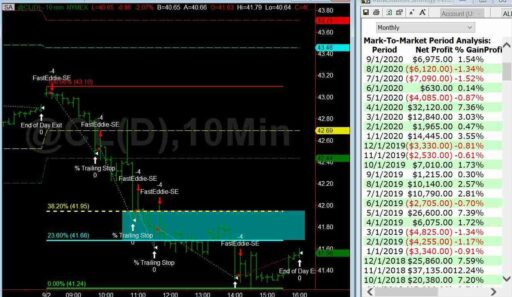Zoom Video Communications, Inc. (ZM) has been a prominent player in the video communications industry, especially highlighted by its performance during the pandemic. As we delve into a detailed analysis of ZM stock, we consider various aspects such as financial performance, strategic initiatives, investment perspectives, market positioning, and historical trends to understand its current standing and future potential. The company’s recent venture into AI, a significant share buyback program, and its resilience in the face of slowing revenue growth offer a complex picture for investors.
Key Takeaways
- Zoom’s recent quarterly results have surpassed Wall Street’s expectations, indicating a robust financial performance.
- The company’s strategic expansion into AI and a sizeable share buyback program reflect proactive corporate actions in response to market challenges.
- Investment analysts are giving mixed signals, with an average price target suggesting a moderate upside potential for ZM stock.
- Despite a tumultuous historical performance with significant highs and lows, Zoom maintains a strong valuation score and market position.
- Zoom’s future outlook remains cautiously optimistic, with investment sentiment leaning towards a buy-and-hold strategy for long-term growth.
Zoom’s Financial Performance: Beyond the Numbers

Recent Quarterly Results and Market Reaction
Zoom Video Communications’ recent quarterly results have been a testament to the company’s resilience and strategic focus. The fourth quarter of fiscal year 2024 saw Zoom surpassing Wall Street’s expectations with a profit that far exceeded forecasts, alongside a commendable sales performance. The stock responded positively to these results, with an 11% surge in late trading following the earnings announcement.
Zoom’s continued success is reflected in its Enterprise customer base, which grew to approximately 220,400, marking a 3.5% increase year over year. This growth, coupled with the company’s efficiency initiatives, contributed to the quarter’s financial beats. However, it’s important to note the mixed signals in the market reaction. While the earnings beat and raised guidance for the next quarter’s revenue and adjusted operating profit were well-received, concerns have been raised over the slowdown in new contract wins and a dip in the revenue retention rate.
Zoom’s ability to consistently beat consensus EPS estimates throughout fiscal 2024, including the fourth quarter, underscores its long-term strengths and strategic initiatives, such as the newly announced $1.5 billion stock buyback program.
Despite the challenges, the company’s full-year revenue and adjusted operating profit guidance have been raised, indicating a positive outlook. Investors are closely monitoring these developments as they weigh the potential for sustained growth against the backdrop of a competitive market.
Revenue Growth and Profitability Trends
Zoom’s financial landscape has been marked by a steady climb in revenue, particularly within its enterprise segment. In the fourth quarter, Zoom’s revenue climbed 2.7% year over year, with enterprise revenue rising 4.9% to $667.3 million. This growth, coupled with cost-saving measures, has led to a significant improvement in financial performance, including a 66% increase in operating cash flow to $351.2 million.
Zoom’s ability to maintain a robust operating cash flow margin above 35% reflects its operational efficiency and the success of its strategic initiatives.
The company’s recent earnings beat and positive guidance have also contributed to a favorable market perception. A ‘beat and raise’ quarter 9 months ago saw the stock surge by 9.5%, with first quarter results surpassing expectations in revenue, free cash flow, and adjusted operating income. Earnings per share outperformed by 17%, and the company provided solid guidance for the upcoming quarter’s revenue and adjusted operating profit.
| Fiscal Year Ending | Revenue ($B) | Revenue Growth (%) | P/S Ratio |
|---|---|---|---|
| January 31, 2024 | 4.53 | 3.06 | N/A |
Stock Valuation Metrics and Investor Sentiment
Zoom’s valuation metrics present a nuanced picture of the company’s financial standing. The forward P/E GAAP ratio of 47.46 suggests a premium compared to the sector median of 27.82, indicating potential overvaluation. However, when considering the broader market and digital trends, some analysts argue that Zoom’s stock offers a fair price for its growth potential.
Despite the seemingly high valuation, the market sentiment around Zoom reflects a belief in the company’s growth trajectory and its ability to capitalize on the sustained demand for digital communication solutions.
Here’s a quick comparison of Zoom’s valuation metrics against sector medians:
| Metric | Zoom’s Value | Sector Median |
|---|---|---|
| Forward P/E GAAP Ratio | 47.46 | 27.82 |
Investor sentiment is cautiously optimistic, with many acknowledging the risks but also recognizing Zoom’s strong position in a growing industry. The stock’s current valuation reflects a balance between these growth expectations and the inherent uncertainties of the market.
Strategic Initiatives and Corporate Actions

Expansion into Artificial Intelligence
Zoom Video Communications is actively pursuing the integration of artificial intelligence (AI) into its suite of products, signaling a strategic shift towards more advanced technologies. The company’s investment in AI startup Anthropic and the development of Zoom IQ are clear indicators of this direction. Zoom IQ, for instance, is designed to enhance workplace collaboration by summarizing chat threads, organizing ideas, and assisting in the creation of various content for communication.
In the realm of customer service, Anthropic’s AI model is set to enhance Zoom’s Contact Center platform, promising to improve user experience and efficiency. This move is part of a broader trend where large corporations are leveraging generative AI to transform business operations.
Zoom’s foray into AI not only reflects its commitment to innovation but also positions the company to remain competitive in a rapidly evolving industry.
The table below outlines key AI initiatives by Zoom and their expected impact:
| Initiative | Description | Expected Impact |
|---|---|---|
| Zoom IQ | AI-powered collaboration tool | Streamlines communication and content creation |
| Anthropic Investment | Partnership for AI research | Enhances customer service capabilities |
| Docs | AI-powered workspace for 2024 | Facilitates documentation and project management |
These initiatives demonstrate Zoom’s radical integration of advanced technologies, including AI, virtual reality, and augmented reality, aimed at providing efficient and cost-effective alternatives to traditional corporate interactions.
Share Buyback Program and Its Implications
Zoom’s recent announcement of a share buyback program has been a significant development, with the company’s board of directors authorizing the repurchase of up to $1.5 billion of its common stock. This move is seen as a strong signal of confidence from the company in its own stock value, suggesting that the leadership believes the shares are currently undervalued.
The market’s reaction to this news was notably positive, reflecting investor optimism about the potential impact on Zoom’s earnings per share. The buyback program is expected to be accretive to earnings, as it could reduce the number of outstanding shares and potentially increase shareholder value.
The initiation of a stock buyback program often indicates a company’s belief in its long-term prospects and financial stability.
Analysts have pointed out that this strategic decision addresses some of the uncertainties regarding Zoom’s use of its cash reserves. It also raises questions about the company’s approach to future acquisitions and investments, as repurchasing shares could limit the capital available for such activities.
Zoom’s Response to Slowing Revenue Growth
In the face of slowing revenue growth, Zoom has taken decisive steps to bolster its financial health and reassure investors. The company’s Q4 results showcased a modest year-over-year revenue increase, driven largely by its enterprise segment. Despite the broader market’s concerns, Zoom’s enterprise revenue rose to $667.3 million, a 4.9% increase from the previous year.
Zoom’s strategic focus on enterprise customers is a deliberate move to stabilize revenue streams and offset the plateauing growth in the consumer segment.
Zoom’s commitment to financial discipline is evident in its improved operating cash flow, which surged by 66% year over year, achieving an impressive margin above 35%. Additionally, the company has demonstrated its confidence in its long-term prospects by announcing a new $1.5 billion stock buyback program.
The company’s ability to consistently beat consensus EPS estimates throughout fiscal 2024, including a notable beat in Q4 with an adjusted $1.42 per share, signals underlying strengths that may not be fully appreciated by the market.
Investment Perspectives on ZM Stock

Analysts’ Ratings and Price Targets
The consensus among analysts suggests a cautious stance on ZM stock, with the average rating being a "Hold." The 12-month price target stands at $78.0, indicating a potential upside of 10.28%. This figure is derived from a spectrum of opinions, ranging from JPMorgan Chase’s reduced target of $80 to a more optimistic view from other quarters.
The diversity in analysts’ opinions reflects the complexity of forecasting Zoom’s future in a rapidly evolving market.
Analysts’ assessments vary significantly, as evidenced by differing price targets and ratings:
| Analyst | Rating | Price Target |
|---|---|---|
| JPMorgan Chase | Neutral | $80 |
| TipRanks Consensus | Hold | $76.25 |
These varying perspectives underscore the challenges in predicting Zoom’s performance, with factors such as market trends and strategic initiatives playing a crucial role.
Buy-and-Hold Strategy: Is Zoom a Long-Term Play?
The question of whether Zoom (ZM) is a suitable candidate for a buy-and-hold investment strategy is complex, particularly in light of its recent performance. Zoom’s stock has experienced significant volatility, with a notable downturn from its peak market-darling status. This shift in sentiment may attract contrarian investors, but caution is advised due to the stock’s low momentum across various time frames.
While some analysts believe that Zoom’s current valuation is fair and that the company will remain a strong competitor in the video communications industry, potential investors should consider the likelihood of short-to-medium term negative returns before any appreciation in stock value.
Zoom’s financials are a critical factor in determining its long-term viability. Here’s a snapshot of Zoom’s recent performance metrics:
| Metric | 3M Performance | 6M Performance | 9M Performance | 1Y Performance |
|---|---|---|---|---|
| Return | -X% | -Y% | -Z% | -W% |
(Note: Replace X, Y, Z, W with actual performance percentages when available.)
Investors considering a long-term position in Zoom should weigh these factors carefully, alongside the company’s growth potential and competitive advantages within the industry.
Comparing Zoom to Its Industry Peers
When evaluating Zoom’s position relative to its industry peers, it’s crucial to consider a variety of financial and strategic factors. Zoom’s net income margin significantly outpaces the sector median, highlighting its efficiency in generating profit relative to its competitors. However, this figure is less impressive when compared to companies of a similar market cap within the information technology sector.
Zoom’s momentum metrics present a cautionary tale for investors, with the company underperforming the sector across multiple time frames. This suggests potential short-to-medium term volatility before any positive trend reversal.
| Metric | Zoom | Sector Median | Difference |
|---|---|---|---|
| Net Income Margin | 5.21% | 2.52% | +107.08% |
| Forward P/E GAAP Ratio | 47.46 | 27.82 | +70.58% |
| Equity-to-Asset Ratio | 0.8 | – | – |
| Total Debt/Equity (TTM) | Low | – | – |
Despite these mixed signals, Zoom’s strong balance sheet, characterized by a high equity-to-asset ratio and minimal debt issuance, positions it as a potentially robust investment. The company’s valuation, when considering forward P/E ratios and other financial metrics, suggests that it may be fairly valued or even undervalued, offering a margin of safety for investors.
While the market’s sentiment has shifted, and Zoom no longer enjoys the ‘market-darling’ status, its solid financials and strategic positioning could make it an attractive option for contrarian investors seeking value opportunities.
Zoom’s Market Position and Competitive Landscape

Zoom’s Place in the Video Communications Industry
Zoom Video Communications, Inc. has established itself as a key player in the video communications industry, providing a unified communications platform that spans across various regions including the Americas, Asia Pacific, Europe, the Middle East, and Africa. Zoom’s success can be attributed to its comprehensive suite of products, such as Zoom Meetings, Zoom Phone, and Zoom Chat, which cater to a wide range of communication needs from HD video and voice to content sharing across multiple devices.
The company’s freemium business model has been pivotal in customer retention, offering a basic video-calling package for free while placing limits on group call participants and meeting lengths. This strategy, coupled with high ratings for ease of use, has allowed Zoom to maintain a strong market presence despite the emergence of significant competitors.
Zoom’s main competitors include Google Meet, Microsoft Teams, and Slack, which present formidable challenges in the video conferencing space. Exposure to Zoom is considered the most direct way to access video conferencing services, especially as its competitors are part of larger, diversified enterprises.
Zoom’s future in the industry hinges on its ability to evolve into a broader communications platform for business customers. With the post-pandemic landscape shifting, Zoom’s strategic response and innovation will be crucial in maintaining and enhancing its market position.
Competitive Advantages and Challenges
Zoom’s ability to maintain its market position hinges on its competitive advantages and the challenges it faces in a rapidly evolving industry. Zoom’s competitive advantage is derived from its high-quality video and audio conferencing, which has become synonymous with remote communication. The platform’s user-friendly interface has also contributed to its widespread adoption, making it accessible to users of varying technical skill levels.
However, challenges persist in the form of intense competition from other tech giants and emerging startups. The company must continuously innovate to stay ahead, as competitors are quick to replicate successful features. Additionally, Zoom faces the task of diversifying its revenue streams to reduce reliance on its core video conferencing service.
Zoom’s valuation at this time is fair, offering a good price for what is considered a growth opportunity based on high digital trends.
The table below outlines some of the key competitive advantages and challenges that Zoom faces:
| Competitive Advantages | Challenges |
|---|---|
| High-Quality Video and Audio | Intense Competition |
| User-Friendly Interface | Feature Replication by Competitors |
| Strong Brand Recognition | Diversification of Revenue Streams |
Zoom’s strategic response to these challenges will be critical in determining its future success and ability to deliver value to shareholders.
The Impact of Market Trends on Zoom’s Strategy
The market trends significantly influence Zoom’s strategic direction. The proliferation of advanced features and integrations within Zoom’s platform is a direct response to evolving user demands and competitive pressures. This has not only influenced market adoption trends but has also set a new standard for what users expect from video conferencing tools.
Market volatility and perception shifts are critical factors for Zoom. The company’s shares have experienced significant fluctuations, with rare moves greater than 5% indicating pivotal moments for investor confidence. Such volatility underscores the importance of Zoom’s ability to adapt and innovate in a dynamic market.
Zoom’s agility in responding to market trends and its robust cash flows position it uniquely in the video communications industry. Despite facing headwinds, Zoom’s strategic initiatives aim to sustain its growth and address investor concerns about its valuation and future prospects.
Historical Performance and Future Outlook

Zoom’s Stock Performance Since IPO
Zoom’s initial public offering (IPO) in April 2019 was a significant event in the company’s history, marking its transition from a private to a public entity. The IPO raised $752 million, with shares priced at $36. On the first day of trading, ZM stock soared, closing with a 72% increase. This bullish investor sentiment was a testament to the market’s confidence in Zoom’s potential.
Zoom’s stock performance has been a rollercoaster since its IPO. After peaking at $588.84 in October 2020, the stock experienced a sharp decline, dropping 45% in 2021 and tumbling an additional 63% in 2022 as revenue growth slowed. Despite these fluctuations, Zoom has consistently beaten consensus EPS estimates every quarter of fiscal 2024, showcasing its resilience and potential for recovery.
Zoom’s recent financial results and strategic moves, such as the announcement of a new $1.5 billion stock buyback program, reflect the company’s commitment to creating shareholder value and its belief in the stock’s underlying strength.
Here’s a snapshot of Zoom’s stock performance post-IPO:
| Date | Event | Stock Price Change |
|---|---|---|
| Apr 2019 | IPO at $36/share | – |
| Oct 2020 | Peaked at $588.84 | – |
| 2021 | Dropped 45% | – |
| 2022 | Tumbled 63% | – |
| Feb 2023 | 52-week high of $74.59 | – |
| Fiscal 2024 | Consistently beat EPS estimates | – |
Investors who have been with Zoom since its IPO have witnessed both impressive gains and notable declines. The company’s ability to navigate the volatile market and maintain a trajectory of growth, despite challenges, will continue to be a focal point for investors and analysts alike.
Future Projections: Growth Potential and Risks
As we look towards the future, Zoom’s growth trajectory is a blend of optimism and caution. The company’s stock forecast, as per StockAnalysis.com, suggests a moderate rise for 2024, with an average forecast of $80.11, indicating a potential increase of 17.53%. This projection, while promising, is not without its challenges.
Zoom’s valuation, currently reflected by a forward PE to Growth (PEG) ratio of 1, suggests that the market may be overvaluing the company in relation to its projected growth. A PEG ratio above the fair market value signals that investors are paying a premium for expected growth, which may or may not materialize as anticipated.
In assessing Zoom’s future, it’s crucial to consider the balance between its high-growth potential and the inherent risks associated with such rapid expansion. The company’s ability to maintain its growth rate while navigating market fluctuations will be key to its long-term success.
Analysts have outlined scenarios for Zoom’s earnings, suggesting a need for a 10.2% EPS growth rate over the next decade to justify its current valuation. This is coupled with a 4% terminal stage growth rate and an 11% discount rate, painting a picture of cautious optimism for the company’s financial health.
Investor Expectations and Market Sentiments
As Zoom navigates through the ebbs and flows of the market, investor expectations have become a pivotal factor in the stock’s performance. Market sentiments fluctuate, often influenced by broader industry trends and Zoom’s own strategic moves. Investors are keenly watching Zoom’s ability to sustain growth in a post-pandemic world, where remote work may not be as prevalent.
The anticipation of Zoom’s future success is closely tied to its adaptability and innovation in a market that is no longer in a state of emergency-induced expansion.
Investor sentiments can be summarized as follows:
- Optimism about Zoom’s potential to expand its product offerings and maintain a high retention rate among its users.
- Concerns regarding the increasing competition in the video communications space.
- Expectations of Zoom’s proactive approach to market trends and customer needs.
While the future is uncertain, Zoom’s past performance and current trajectory provide a foundation for investors to build their expectations upon. The table below presents a snapshot of investor sentiment indicators:
| Indicator | Positive Sentiment | Neutral Sentiment | Negative Sentiment |
|---|---|---|---|
| Product Innovation | High | Moderate | Low |
| Market Competition | Low | Moderate | High |
| Customer Retention | High | Moderate | Low |
These indicators serve as a barometer for the market’s belief in Zoom’s capacity to continue its growth and remain a leader in its industry.
Conclusion
In summary, Zoom Video Communications (NASDAQ: ZM) presents a multifaceted picture for investors. The company’s recent foray into AI and better-than-expected quarterly results, coupled with a robust share-buyback program, have given shareholders reasons for optimism. Despite a tumultuous history with significant peaks and troughs in stock price, Zoom’s current valuation score suggests it may be undervalued, offering potential for long-term growth. Analysts’ ratings indicate a cautious approach, with a consensus of ‘Hold’ and a moderate upside potential. As the market continues to evaluate ZM’s performance and strategic initiatives, investors should weigh these factors carefully against their investment goals and risk tolerance before making any decisions.
Frequently Asked Questions
What recent strategic initiative has Zoom Video Communications taken?
Zoom Video Communications has recently ventured into the artificial intelligence trend as part of its strategic initiatives.
Is Zoom currently implementing a share buyback program?
Yes, Zoom has announced a sizable share-buyback program, which has been positively received by the stockholders.
How did Zoom’s stock perform following its recent quarterly results?
Zoom surpassed Wall Street’s top-line and bottom-line estimates, which led to a positive reaction in its stock price.
What is the current valuation score of Zoom (ZM) stock?
Zoom (ZM) stock has received a strong valuation score of 100 from InvestorsObserver analysis, indicating it might be a good value at its current price.
What is the consensus among analysts regarding ZM stock?
The consensus among analysts on TipRanks is a Hold for ZM stock, based on two Buys, five Holds, and two Sell ratings.
How has ZM stock performed historically since its IPO?
ZM stock had a strong debut, popping 72% on its first day of trading in April 2019. It peaked in October 2020 but has since experienced declines, particularly in 2021 and 2022.





